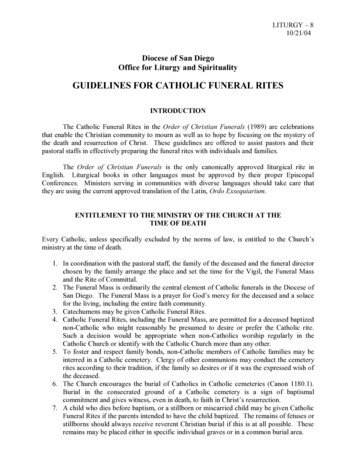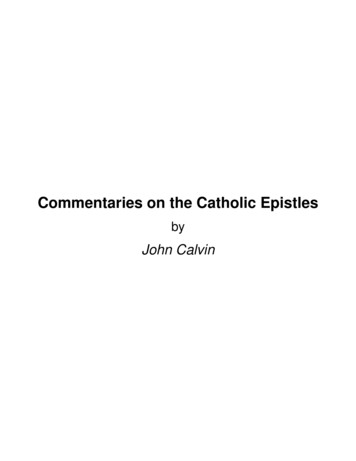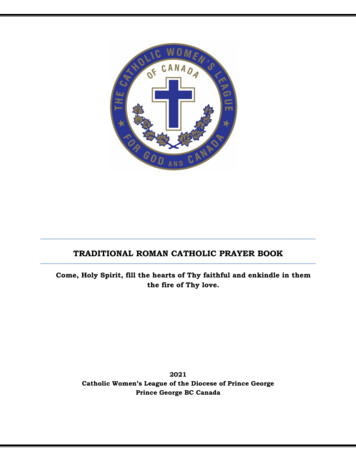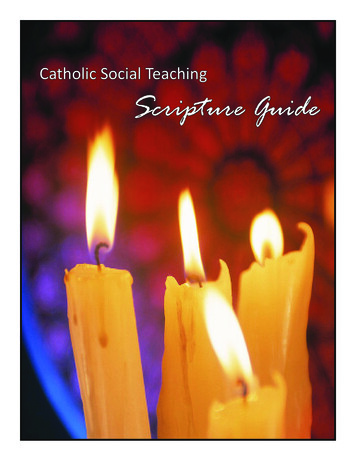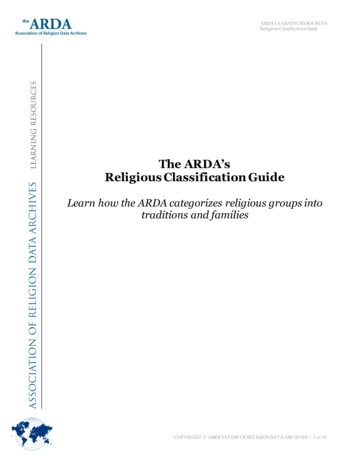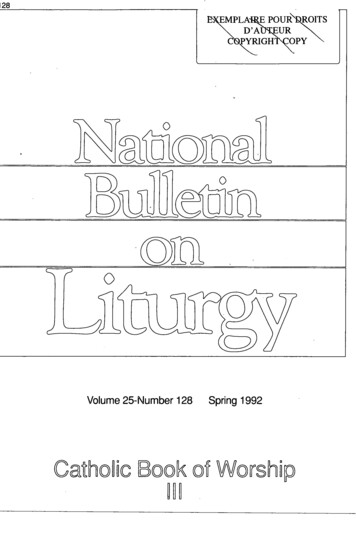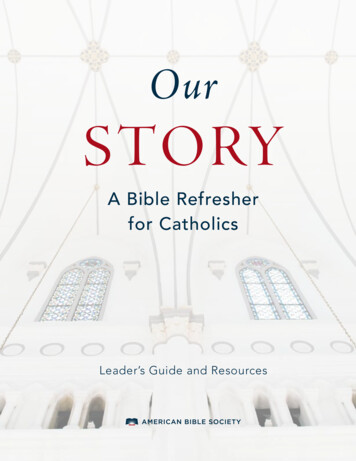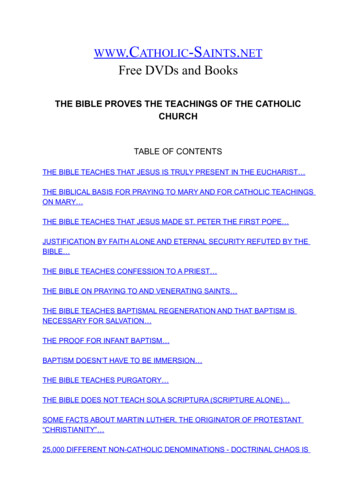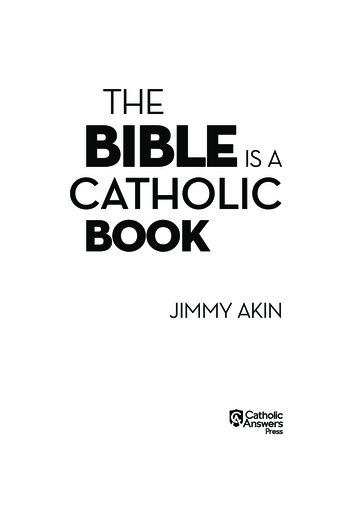
Transcription
THEBIBLEIS ACATHOLICBOOKJIMMY AKIN
2019 Jimmy AkinAll rights reserved. Except for quotations, no part of this book may be reproducedor transmitted in any form or by any means, electronic or mechanical, includingphotocopying, recording, uploading to the internet, or by any informationstorage and retrieval system, without written permission from the publisher.Published by Catholic Answers, Inc.2020 Gillespie WayEl Cajon, California 920201-888-291-8000 orders619-387-0042 faxcatholic.comPrinted in the United States of AmericaCover and interior design by Russell Graphic Design978-1-68357-141-4978-1-68357-142-1 Kindle978-1-68357-143-8 ePub
To the memory of my grandmother,Rosalie Octava Beard Burns,who gave me my first Bible.
CONTENTSTHE BIBLE, THE WORD OF GOD, AND YOU. . 71. THE WORD OF GOD BEFORE THE BIBLE. 112. THE WORD OF GOD INCARNATE. . . . . . . . . . . . . . . . . . . . . . . . . . . . . 473. THE WRITING OF THE NEW TESTAMENT. 794. AFTER THE NEW TESTAMENT. . 129Appendix I: Bible Timeline. . 171Appendix II: Glossary. . 175Endnotes. 179About the Author. . . 181
The Bible, the Word of God,and YouThe Bible can be intimidating. It’s a big, thick book—muchlonger than most books people read. It’s also ancient. Themost recent part of it was penned almost 2,000 years ago.That means it’s not written in a modern style. It can seemstrange and unfamiliar to a contemporary person. Evenmore intimidating is that it shows us our sins and makesdemands on our lives.No wonder some people hesitate to take the plunge andstart reading the Bible!But each of the things that can make it intimidating isactually a benefit: Because the Bible is so large, it contains a great deal ofvaluable information. If it were short, it wouldn’t tell usnearly as much. The fact that it was written so long ago testifies to itstimeless message. Its teachings aren’t tied to just one timeor culture. They have endured, and by reading Scripturewe experience the joy of discovering the story of God’sdealings with mankind. Finally, it’s important that it reveals our sins to us. Weneed wake-up calls that shake us out of our feeble attempts7
T H E B I B LE I S A C AT H O LI C B O O Kto rationalize what we’re doing wrong. And Scripture isquick to assure of us God’s love for us. “For God so lovedthe world that he gave his only Son, that whoever believesin him should not perish but have eternal life” (John 3:16).The Bible is an inestimable gift from God. It’s his wordin written form—something each of us should cherish andstudy regularly.Some groups of Christians try to claim the Bible forthemselves. They make it sound like the Catholic Churchis opposed to Scripture. Some even claim that the Church“hates” the Bible.But as we’ll see, all Christians owe an enormous debt tothe Catholic Church, for it was through the Church thatthe Bible was given to the world. Jesus himself founded theCatholic Church. He appointed its first leaders, and theywere the ones who—under the inspiration of the Holy Spirit—wrote the books of the New Testament, which completed and became the capstone of all the scriptures that hadcome before.The Holy Spirit then guided the Catholic Church to discern which books belonged in the Bible and which did not.This involved the crucial process of sorting the true scriptures from all of the false ones that existed.The Catholic Church laboriously copied the scriptures inthe age before the printing press, when every book—including lengthy ones like the Bible—had to be written by hand.It thus preserved these books through the centuries, unlikeso many ancient works that have now been lost.The Catholic Church is why we have the Bible today, andeveryone should be grateful for the gift that, by the grace ofGod, it has given to the world.The Bible is a Catholic book!8
1The Word of GodBefore the BibleIN THE BEGINNING WAS THE WORDHow the world began is a question people everywhere ask.It’s a human universal.Pagan cultures thought the world was made by theirgods and goddesses. Some myths claimed that the godsreproduced sexually to make the elements of the world.Others held that there was a fierce battle among the gods,and the world was formed from the corpses of the losers.Mankind was then created as a slave race to relieve the godsof drudgery.The book of Genesis set the record straight: The worldwas not produced by a multitude of finite gods. It was thecreation of a single, great God—one supreme and supremelygood Being who is behind everything.Because of his infinite, unlimited power, he didn’t needto use anything to make the world, as the pagans thought.He didn’t need to mate with a goddess. He didn’t need tobattle other gods and make the world from their corpses.11
T H E B I B LE I S A C AT H O LI C B O O KHe simply spoke, and the elements of the world sprang intoexistence: “God said, ‘Let there be light’; and there waslight” (Gen. 1:3).God made a good world, and to crown his creation, hemade man—not to relieve him of drudgery but to serve ashis representative, ruling over creation:God created man in his own image, in the image of Godhe created him; male and female he created them. AndGod blessed them, and God said to them, “Be fruitfuland multiply, and fill the earth and subdue it; and havedominion over the fish of the sea and over the birds ofthe air and over every living thing that moves upon theearth.” And God saw everything that he had made, andbehold, it was very good (Gen. 1:27–28, 31).Through the ages, God continued to speak. Even whenman fell into sin, he sent the prophets to correct him andcall him back to communion with his Creator. Eventually,he sent his Son, Jesus, to redeem mankind and to proclaimhis definitive word to us:In many and various ways God spoke of old to our Fathers by the prophets; but in these Last Days he hasspoken to us by a Son, whom he appointed the heirof all things, through whom also he created the world(Heb. 1:1–2).The Gospel of John reveals more about God’s Son andhow the world was made:In the beginning was the Word, and the Word was withGod, and the Word was God. He was in the beginning12
T H E WO R D O F G O D B EFO R E T H E B I B LEwith God; all things were made through him, andwithout him was not anything made that was made( John 1:1–3).This reveals that Jesus—God’s Son—was the Word hespoke when he created the world and everything in it.When God said, “Let there be light,” it was through Jesusthat this happened.Because Jesus was there in the beginning—one of theuncreated, divine Persons of the Trinity—he is the originaland supreme Word of God. All of God’s other words areshadows of him.This is important to remember, because some today usethe phrase “word of God” as if it just meant “the Bible.” Although the Bible is important, the word of God is not confined to or only found in it. First and foremost, Jesus Christhimself is the Word of God, and there are other expressionsof it, only some of which are found in Scripture.THE SPIRIT OF GODThe Father and the Son are two of the divine Persons of theHoly Trinity, but what about the third—the Holy Spirit?Theologians tell us that every time God performs an action in the world, all three Persons play a role. For example,to save mankind, God the Father sent the Son to redeem us,and he and the Son together send the Holy Spirit to drawus back to him and bring his grace into our lives. Consequently, it’s no surprise that we find the Spirit of God alsotook part in the creation of the world:In the beginning God created the heavens and the earth.The earth was without form and void, and darkness was13
T H E B I B LE I S A C AT H O LI C B O O Kupon the face of the deep; and the Spirit of God was moving over the face of the waters (Gen. 1:1–2).In the biblical languages, the word for spirit is the same asthe word for breath, so Scripture indicates that God createdby both his word and his spirit, or breath:By the word of the Lord the heavens were made, and alltheir host by the breath of his mouth (Ps. 33:6).Although the doctrine of the Trinity would not be fullyrevealed until the New Testament age, this passage shows howboth the Son (the Word) and the Spirit were active in creation.The image the passage uses is based on the fact that,when we speak, it is our breath that carries our words. Inspeech, our breath and our words are intertwined. Theyalways go together, and so it is with God. When God sentprophets, it was the Holy Spirit who gave them God’s word.The prophet Zechariah records how God’s people refusedto listen to the message that the Holy Spirit gave throughthe prophets:They made their hearts like adamant lest they should hearthe law and the words which the Lord of hosts had sent byhis Spirit through the former prophets. Therefore, greatwrath came from the Lord of hosts (Zech. 7:12).The Holy Spirit continued to be active in the New Testament era, even after Jesus’ ministry. At the Last Supper, Jesustold his disciples:I have yet many things to say to you, but you cannot bearthem now. When the Spirit of truth comes, he will guide14
T H E WO R D O F G O D B EFO R E T H E B I B LEyou into all the truth; for he will not speak on his ownauthority, but whatever he hears he will speak, and hewill declare to you the things that are to come. He willglorify me, for he will take what is mine and declare it toyou ( John 16:12–14).One of the ways the Holy Spirit communicates God’sword to us is in writing. The Latin word for writing is scriptura, and so the writings that the Holy Spirit produced areknown as Scripture. St. Peter says:First of all, you must understand this, that no prophecyof Scripture is a matter of one’s own interpretation, because no prophecy ever came by the impulse of man,but men moved by the Holy Spirit spoke from God (2Pet. 1:20–21).St. Peter indicates that, although the human author wasresponsible on one level for writing a book of Scripture, ona more fundamental level it was the Holy Spirit workingthrough them. The name for the process by which the HolySpirit did this is inspiration. This word comes from Latinroots that mean “to breathe into” (in spirare).To say that a book of Scripture is inspired is to say thatGod has breathed the words it contains. This is the way theNew Testament describes inspiration in Greek: it is God(theos) breathed (pneustos). Thus St. Paul says:All Scripture is inspired by God [theopneustos] and profitable for teaching, for reproof, for correction, and fortraining in righteousness, that the man of God maybe complete, equipped for every good work (2 Tim.3:16–17).15
T H E B I B LE I S A C AT H O LI C B O O KTo say that Scripture is inspired or God-breathed does notmean that the biblical authors were mere secretaries, writingdown what they heard God dictate by an inner voice. TheHoly Spirit worked through them in an organic way, usingtheir minds, talents, and life experiences. When St. Paul says, “Imyself am an Israelite, a descendant of Abraham, a member ofthe tribe of Benjamin” (Rom. 11:1), he is speaking of himself asa human being, and he is serving as a true author. The SecondVatican Council explained the process of inspiration this way:To compose the sacred books, God chose certain menwho, all the while he employed them in this task, madefull use of their powers and faculties so that, though heacted in them and by them, it was as true authors thatthey consigned to writing whatever he wanted written,and no more (Dei Verbum 11).Today, we are fortunate to have Scripture, an inspiredcollection of writings that convey God’s word to us. However, it’s important to remember that this has not alwaysbeen the case. In fact, for most of human history, God’speople didn’t have Scripture.THE AGE OF THE SPOKEN WORDSpeech is a human universal, but writing is not. There wasan age before writing had been invented.Although we don’t know the exact date that writing began, we do have a pretty good idea of how it developedbecause archaeologists have discovered a trove of ancientdrawings, artifacts, and inscriptions that reveal its history.The earliest human signs were a kind of protowriting thatconsisted of pictures and markings that carried only a basic16
T H E WO R D O F G O D B EFO R E T H E B I B LEmeaning. We often can’t tell what that meaning was, butsometimes we can. For example, we have cave paintings thatclearly represent horses, stars, people, and spears. We also haveartifacts with notches or knots that were used to count items.Recreation of a cave painting from the Ardéche valley in France,35,000–30,000 B.C.The signs used in protowriting convey only a limitedamount of information. They can’t represent everythingthat we can communicate in speech. For this reason, speechwas the primary means humans had to communicate witheach other. It was the age of the spoken word—the firstphase of human history.God made himself known to man in this period. Genesisshows God giving the commission to have dominion over theearth and to rule and care for it on his behalf. It records him settling Adam in the garden of Eden, giving him the commandment regarding what he could eat, allowing him to name theanimals, and being both just and merciful with him when hefell into sin. The Catechism of the Catholic Church (CCC) explains:God, who creates and conserves all things by his word,provides men with constant evidence of himself increated realities. And furthermore, wishing to open upthe way to heavenly salvation, he manifested himself to17
T H E B I B LE I S A C AT H O LI C B O O Kour first parents from the beginning. He invited themto intimate communion with himself and clothed themwith resplendent grace and justice.This revelation was not broken off by our first parents’sin. After the fall, God buoyed them up with the hopeof salvation, by promising redemption; and he has neverceased to show his solicitude for the human race. For hewishes to give eternal life to all those who seek salvationby patience in well-doing (54–55).All this took place at the dawn of human history. Godthus came to man and made his word known even beforethe development of writing.THE AGE OF THE WRITTEN WORDThe archaeological record reveals when writing began. Itdidn’t happen everywhere all at once, and forms of protowriting continued to be used in many places. But in two locations—Mesopotamia and Egypt—the first systems of truewriting appeared.Around 3300 B.C., the Mesopotamians began to write onclay tablets using pictograms, or picture writing, and overthe next few centuries these became progressively more sophisticated. By around 2600 B.C., they had developed intocuneiform, a system of wedge-shaped marks pressed intoclay. These included symbols that represented the syllablesof their languages, so anything you could say out loud youcould now preserve in writing.By 3100 B.C., the Egyptians had begun developing theirown writing system, which eventually resulted in the hieroglyphs for which Egypt is famous. Before these weredeciphered in the nineteenth century, it was thought they18
T H E WO R D O F G O D B EFO R E T H E B I B LEwere pictograms, but it turned out they were a sophisticatedsystem that incorporated an alphabet, so anything you couldsay could be written down in full.Writing didn’t catch on everywhere. It took centuries forthat to happen, and different peoples adopted it at widelydifferent times. The earliest Chinese writing didn’t beginuntil around 1300 B.C., the Mayans began to write around300 B.C., and the Cherokee tribe in North America didn’thave writing until 200 years ago!Hieroglyphs (above) & Cuneiform (below)What about the Hebrews? The earliest alphabet used bythe Hebrews is known as the Proto-Sinaitic script. It is usedin inscriptions found in the Sinai Peninsula, between Egyptand Israel. These inscriptions date to around 1600 B.C. Although scholars agree that this script was used to write alanguage that belonged to the same family as Hebrew, it isn’tclear that Hebrew itself was being spoken at the time. Languages develop over centuries through a long, slow process,and we don’t have clear evidence that Hebrew was beingspoken until about 1000 B.C.Just because writing existed didn’t mean everyone understood it. Very few people at that time were capable of reading—often only government officials and priests could read. In fact,hieroglyphs have the name they do because they were usedby the Egyptian priests, and so they counted as sacred (Greek,19
T H E B I B LE I S A C AT H O LI C B O O Khieros) carvings (gluphai). Even those who could read usually didn’t write. That was a task performed by professionalscribes. If a king or a priest—or anyone else—wanted something written down, he would have a scribe do it for him.Proto-Sinaitic inscriptionThough writing had been invented, most people werestill, effectively, living in the age of the spoken word. Theearly events of Genesis all took place before writing wasinvented, and even though it was in use by the time of Abraham, he and the other patriarchs were operating in an almost exclusively oral environment.In the Bible, the first mention of anyone writing something down doesn’t occur until after the Exodus was underway. When God wanted a particular event remembered, hesaid, “Write this as a memorial in a book and recite it in theears of Joshua” (Exod. 17:14). It made sense for the Hebrewsto use writing at this time because Moses grew up amongpeople who could write. He had been raised in Pharaoh’shousehold (Exod. 2:1–10), and Pharaoh was the ruler andchief priest of Egypt.But how do we know about the things that preceded theHebrews’ use of writing?TRADITION!Any time information is passed from one person to another, it is an example of tradition. The word tradition comesfrom the Latin root tradere, which means “to hand over” or“to pass on.”20
T H E WO R D O F G O D B EFO R E T H E B I B LEBecause our culture is highly literate, we focus on information being passed down in written form—in writtentradition—and so we often overlook the way informationis passed down in oral cultures, which is by oral tradition.But that was the way most people got their informationin the ancient world, and it worked well. From one generation to another, people would orally pass on the informationthat was needed—about their history, their land, their skills.The method worked well enough that writing didn’t haveto be invented for thousands of years, and it’s why writingdidn’t catch on everywhere all at once. Peoples living nearliterate cultures could go hundreds of years without developing a literature of their own.One reason oral tradition worked so well is that therewere ways of transmitting it in a controlled, accurate fashion.Not just anyone could be a tradent—an authorized bearer oftradition. To qualify, a person had to have a good memory,good communication skills, and specialized knowledge ofthe subject on which he was an authority.Tradents memorized information by putting it in a memorable form, like when a modern speaker learns the outlineof his talk before he gives it in public. Often, ancient tradents would structure information using meter, rhyme, andmelody, so that the lore they had to impart took the form ofpoetry or song. Famous examples include the ancient Greekrhapsodes, who memorized and then performed lengthyworks like Homer’s Iliad and Odyssey.One way of structuring information was what scholarscall a chiasm. This is a way of ordering information aroundkey words or themes in a kind of inverted structure, likethe steps of a pyramid. A simple example of a chiasm is Jesus’ saying, “The last will be first, and the first last” (Matt.20:16). This saying has the following structure:21
T H E B I B LE I S A C AT H O LI C B O O KA: The lastB: will be firstB’: and the firstA’: lastChiasms are useful memory tools, because if you can remember the first half of the structure, you know what thesecond half will be. The example above is short, but ancientauthors—including Homer—used longer, more complexones to organize large amounts of information.These techniques were used among the Hebrews. Thebook of Genesis is built around a series of chiasms,1 andscholars have generally concluded that the oldest portions ofthe Old Testament are found in certain poems or songs, suchas the Blessing of Jacob (Gen. 49), the Song of the Sea (Exod.15), the Blessing of Moses (Deut. 33), and the Song of Deborah (Judg. 5). These are often held to represent ancient oraltraditions that were eventually incorporated into Scripture.The important thing is that before he began to inspireScripture, God used and guided the traditions of his peoplethrough the long ages before the first biblical author beganto write.THE FIRST BOOKS OF SCRIPTURE WRITTENEventually, God inspired the first biblical author. Preciselywho this was is debated.The books of the Old Testament generally don’t say whenthey were written. Sometimes the authors will date specificthings. For example, Isaiah tells us that the vision found inchapter six of his book was something he saw “in the yearthat King Uzziah died” (i.e., 740 B.C.), but that doesn’t tellus when the whole book was issued.22
T H E WO R D O F G O D B EFO R E T H E B I B LEThe biblical authors were communicating a timeless message that was meant to last forever, but modern writers havebeen very curious about the exact times the individual authors wrote.Because it deals with the creation of the world, the bookof Genesis discusses the earliest events, but that doesn’t meanit was written first. Genesis belongs to a set of five books,which also includes Exodus, Leviticus, Numbers, and Deuteronomy. Together, they are referred to as the Pentateuch(Greek, pentateukhos, or “five books”). Because they arewritten to form a set, scholars have generally held that they,or most of them, were published at about the same time.Historically, the common view was that Moses wrotethem, which would place them either in the 1400s B.C. orthe 1200s B.C., depending on when one dates the Exodus.But there are reasons to question this view.Although Moses is the key figure in these books, andthey do record traditions that go back to him, they neverclaim—as a whole—to be written by him. They also contain an account of his death (Deut. 34), and the final formof these books clearly came after Israel had a monarchy, forGenesis looks back on events “before any king reigned overthe Israelites” (Gen. 36:31).A theory known as the Documentary Hypothesis becamepopular in the nineteenth and twentieth centuries. According to this theory, the Pentateuch is based on four documents (the Yahwist, Elohist, Priestly, and Deuteronomistic sources) that were written between the tenth and sixthcenturies B.C. and later combined and published, perhapsaround the fifth century B.C. In the last few decades, theDocumentary Hypothesis has come under increasing criticism from both conservative and liberal scholars, and atpresent there is no consensus.23
T H E B I B LE I S A C AT H O LI C B O O KIf the books of the Pentateuch weren’t the first ones written, which book might have been? Some have pointed tothe book of Job, whose central figure appears to live in theage of the patriarchs, before Israel became a nation. But eventoday we write books about revered figures from the past, sothis doesn’t tell us when Job was composed.Some of the early biblical authors were prophets. Figuressuch as Isaiah, Hosea, Amos, and Micah all wrote in theeighth century B.C.The Church doesn’t have a position on precisely when individual books of Scripture were written or how they werecomposed. It leaves these matters to scholars. From a perspective of faith, the important thing is that God began togive his inspired word to man. The precise dates on whichhe did so are secondary.THE CANON BEGINS TO FORMScholars frequently discuss a concept known as the canon ofScripture. This is based on the Greek word kanôn, whichmeans a rule or measuring rod. It came to mean an authoritative standard, and so the canon of Scripture is the collection of writings that are divinely authoritative.The Pentateuch was the first authoritative collection ofbooks. These books tell how the people of Israel came tobe, as well as God’s law for Israel, so they became the corebooks of Scripture for his people and thus the first part ofthe biblical canon.The importance of these books is indicated by theirname in Hebrew. They are called the Torah—a wordmeaning “instruction.” They contain the fundamental instructions God gave Israel. Later, when the Old Testamentwas translated into Greek, they became known as the Law24
T H E WO R D O F G O D B EFO R E T H E B I B LE(Greek, nomos), which is why they’re referred to as the Lawof Moses.They became an authoritative collection early. This isshown by the fact that the Samaritans have their own Pentateuch. The Samaritans are descended from the ten northerntribes of Israel. They seceded and formed their own nationaround 930 B.C., resulting in the northern kingdom of Israeland the southern kingdom of Judah. They were conqueredby the Assyrians around 723 B.C., and many were deported,but there is still a community of Samaritans in Israel. Theyworship Yahweh, the God of Israel, though they do so onMt. Gerizim, in their own territory, rather than in Jerusalem.They have a version of the Torah, known as the Samaritan Pentateuch, that includes the same books as the Jewishone and differs only in minor details. This indicates thatit has an early date and was considered authoritative—canonical—from early times. It’s also significant because theSamaritans accept as canonical only the five books of Moses.They don’t accept the other books of the Old Testament,which suggests that the Pentateuch was the first group tobe canonized and that the canon gradually expanded afterthis time.NEW BOOKS OF SCRIPTURE COMPOSEDThe ten centuries leading up to the time of Christ were anactive period. It was when the Old Testament took shape.The Pentateuch ends with the death of Moses, and thestory of what happened next is continued in a series of historical books. The first, Joshua, tells of the conquest of thepromised land. The book of Judges then records how Godrepeatedly delivered his people from oppression through aseries of divinely chosen military leaders. Ruth focuses on25
T H E B I B LE I S A C AT H O LI C B O O Kthe life of a woman who was an ancestor of Israel’s mostfamous king, David.Israel’s history continues in 1 and 2 Samuel, 1 and 2Kings, and 1 and 2 Chronicles. Each of these was originallya single book, but they are divided in two in modern Bibles.The books of Samuel tell the story of the last of Israel’s judges, how the monarchy was established under King Saul, andhow it was passed to King David.The books of Kings cover the final stage of David’s lifeand how Solomon succeeded him. Following Solomon’stime, the nation split in two, with the ten northern tribesseceding and forming the kingdom of Israel, leaving thesouthern tribes as the kingdom of Judah. The story of thesetwo kingdoms is then related, until Israel is conquered anddeported by the Assyrian empire around 723 B.C. and Judah is conquered and deported by the Babylonian empirearound 587 B.C., beginning the Babylonian Exile.The books of Chronicles cover the same period as thebooks of Samuel and Kings, but they focus on the southernkingdom and provide a supplemental theological perspective on the events.Ezra and Nehemiah, which were originally one book,cover events after the Babylonian Exile. They deal with thepeople’s return to the land of Judah and the rebuilding ofthe temple.Esther also deals with the Babylonian Exile, and it is oftengrouped with the historical books. However, according toPope St. John Paul II, this book has “the character of allegorical and moral narrative rather than history properlyso-called”.2God also began to inspire what are known as wisdombooks. They are devoted to philosophical reflection andthe worship of God. The book of Job is a meditation on26
T H E WO R D O F G O D B EFO R E T H E B I B LEhuman suffering, while Ecclesiastes is devoted to the questfor meaning in life. The Song of Solomon celebrates thelove of man and woman, and Proverbs offers practical advicefor daily living. By far the longest wisdom book is Psalms,which is a collection of hymns.The final type of book God inspired in the Old Testamentperiod is prophetic. Several of these books are significantlylonger than the others, so they are known as the major prophets. They consist of Isaiah, Jeremiah (together with the shortbook of Lamentations), Ezekiel, and Daniel. These prophetsall relate to the Babylonian Exile in one way or another.By contrast, the minor prophets are generally shorter. Thereare twelve such books, and they were originally collectedin a single volume called the Twelve. However, in ChristianBibles they are listed separately. The minor prophets livedbetween the 800s and 400s B.C., meaning they covered theperiod both before and after the Babylonian Exile.THE LAST OLD TESTAMENT BOOKSThe books we’ve covered so far are considered canonical by allChristians. They are often called protocanonical books becausethey were the first (Greek, prôtos) to achieve universal agreement about their status as Scripture. Other books, which tooklonger to be established, are called deuterocanonical books, because agreement on their status came second (Greek, deuteros).In the Protestant community, it is common to hear peoplesay that after Malachi—the last minor prophet—there were“four hundred silent years” in which God inspired no Scripture. However, this is not true. The inspiration of Scripturecontinued right up until the New Testament.Two books written in this period are Tobit, whichtells the sto
Published by Catholic Answers, Inc. 2020 Gillespie Way El Cajon, California 92020 1-888-291-8000 orders 619-387-0042 fax catholic.com . The Bible is a Catholic book! 11 1 The Word of God Before the Bible IN THE BEGINNING WAS THE WORD How the world began is a question people everywhere ask.
